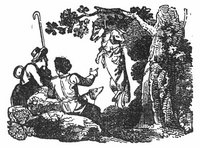Idioms Activities

Idioms Activities
Idioms are a very interesting form of figurative language. They provide us with a new way of looking at the world.
Figurative language enables us to explore language in interesting ways. Figurative language is a form of language that uses concrete, literal images as a base.
The concrete image is combined with a startling and seemingly unrelated image to create something new.
An idiom can be thought of as a cultural metaphor that requires some understanding of word and world knowledge. That is, idioms are sayings that have been used for generations and have become part of the cultural vernacular.
Idioms do require some knowledge about words and how they go together.
An example of a popular idiom is, 'a wolf in sheep's clothing.' If we look closely at the idiom from a literal point of view we have two quite separate and contrasting images.
First, there is the image of the wolf. Historically the wolf is viewed as a predator. We have learnt from stories such as The Three Little Pigs that a wolf is a dangerous creature that cannot be trusted.
Second, we have the image of the sheep. A sheep is an animal that is viewed as relatively docile, harmless and gentle.
Finally, when we combine the image of the wolf with the image of the sheep we have the strange picture of a wolf dressed in sheep's clothing.
Idioms Activities cont...
Now, the two separate images of the wolf and sheep don't normally 'go' together. But the beauty of idioms is that the two images can actually be fused to create a whole new meaning.
To successfully combine the two contrasting images requires a leap of imagination on our part. And idioms, with their creative use of language, are very good at triggering that leap.
So in our example of the wolf, we can picture a wolf actually dressed in sheep's clothing. We can imagine also that the clothing may in fact be a disguise.
We assume this because we know the wolf's nature and that beneath the sheep's clothing it remains a dangerous predator.
Why does the wolf dress in sheep's clothing?
Answer: The wolf is trying to distract us from its true nature. The wolf hopes to trick us into thinking it is harmless; that it is just a sheep.
When we use the idiom of a wolf in sheep's clothing to describe a person we are essentially saying that a particular person cannot be trusted, even though his/her appearance and manner appears harmless to us.
The idiom of a wolf in sheep's clothing reminds us that sometimes we need to look beyond surface appearances to discover a person's true nature.
Sample from a soon to be released Idioms Program: 'On Cloud 9'
Right-click to download this PDF file here.
References
Lazar, G. (2003) Meanings and Metaphors: Activities to Practise Figurative Language, Cambridge University Press
Content Updated 8/11
For a free Idioms program, scroll to the end of this page.
Please sign up for the Language Dispatch newsletter. The newsletter provides essential monthly language intervention tips, techniques and information.
The information provided in the monthly newsletters is ideally suited to be used by speech-language pathologists, teachers and parents of language impaired students.
Once you've signed up to the Language Dispatch you'll also receive a new free Idioms ebook, On Cloud Nine.
The On Cloud Nine Program features 100 context based scenarios, and a multiple choice format to effectively teach this difficult figurative language concept.
The program is very easy to use and is yours free, once you've signed up to the Language Dispatch. The program is available as an Adobe pdf download.

Retiurn from Idioms activities to Pragmatic Language
Enjoy this page? Please pay it forward. Here's how...
Would you prefer to share this page with others by linking to it?
- Click on the HTML link code below.
- Copy and paste it, adding a note of your own, into your blog, a Web page, forums, a blog comment,
your Facebook account, or anywhere that someone would find this page valuable.
|